Serotonergic and Adrenergic Neuroreceptor Manipulation Ameliorates Core Symptoms of ADHD through Modulating Dopaminergic Receptors in Spontaneously Hypertensive Rats
- PMID: 38396978
- PMCID: PMC10888658
- DOI: 10.3390/ijms25042300
Serotonergic and Adrenergic Neuroreceptor Manipulation Ameliorates Core Symptoms of ADHD through Modulating Dopaminergic Receptors in Spontaneously Hypertensive Rats
Abstract
The core symptoms of attention deficit hyperactivity disorder (ADHD) are due to the hypofunction of the brain's adrenergic (NE) and dopamine (DA) systems. Drugs that enhance DA and NE neurotransmission in the brain by blocking their transporters or receptors are the current therapeutic strategies. Of late, the emerging results point out the serotonergic (5-HT) system, which indirectly modulates the DA activity in reducing the core symptoms of ADHD. On this basis, second-generation antipsychotics, which utilize 5-HT receptors, were prescribed to children with ADHD. However, it is not clear how serotonergic receptors modulate the DA activity to minimize the symptoms of ADHD. The present study investigates the efficacy of serotonergic and alpha-2 adrenergic receptor manipulation in tackling the core symptoms of ADHD and how it affects the DA neuroreceptors in the brain regions involved in ADHD. Fifteen-day-old male spontaneously hypertensive rats (SHRs) received 5-HT1A agonist (ipsapirone) or 5-HT2A antagonist (MDL 100907) (i.p.) or alpha-2 agonist (GFC) from postnatal days 15 to 42 along with age-matched Wistar Kyoto rats (WKY) (n = 8 in each group). ADHD-like behaviors were assessed using a battery of behavioral tests during postnatal days 44 to 65. After the behavioral tests, rat brains were processed to estimate the density of 5-HT1A, 5-HT2A, DA-D1, and DA-D2 neuroreceptors in the prefrontal cortex, the striatum, and the substantia nigra. All three neuroreceptor manipulations were able to minimize the core symptoms of ADHD in SHRs. The positive effect was mainly associated with the upregulation of 5-HT2A receptors in all three areas investigated, while 5-HT1A was in the prefrontal cortex and the substantia nigra. Further, the DA-D1 receptor expression was downregulated by all three neuroreceptor manipulations except for alpha-2 adrenergic receptor agonists in the striatum and 5-HT2A antagonists in the substantia nigra. The DA-D2 expression was upregulated in the striatum while downregulated in the prefrontal cortex and the substantia nigra. In this animal model study, the 5-HT1A agonist or 5-HT2A antagonist monotherapies were able to curtail the ADHD symptoms by differential expression of DA receptors in different regions of the brain.
Keywords: 5-HT1A; 5-HT2A; ADHD; DA-D1; DA-D2; alpha-2 adrenergic receptor; attention; impulsivity; prefrontal cortex; striatum and substantia nigra.
Conflict of interest statement
The authors declare no conflicts of interest.
Figures
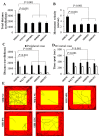
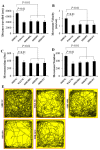


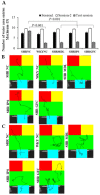
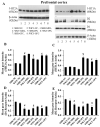
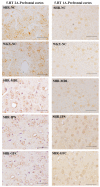
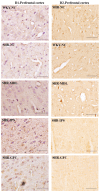

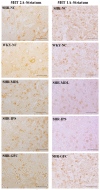
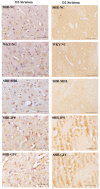

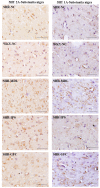

Similar articles
-
Altered dopaminergic function in the prefrontal cortex, nucleus accumbens and caudate-putamen of an animal model of attention-deficit hyperactivity disorder--the spontaneously hypertensive rat.Brain Res. 1995 Apr 10;676(2):343-51. doi: 10.1016/0006-8993(95)00135-d. Brain Res. 1995. PMID: 7614004
-
Effect of atomoxetine on hyperactivity in an animal model of attention-deficit/hyperactivity disorder (ADHD).PLoS One. 2014 Oct 1;9(10):e108918. doi: 10.1371/journal.pone.0108918. eCollection 2014. PLoS One. 2014. PMID: 25271814 Free PMC article.
-
Downregulation of Dopamine D1-like Receptor Pathways of GABAergic Interneurons in the Anterior Cingulate Cortex of Spontaneously Hypertensive Rats.Neuroscience. 2018 Dec 1;394:267-285. doi: 10.1016/j.neuroscience.2018.10.039. Epub 2018 Oct 28. Neuroscience. 2018. PMID: 30394321
-
Hypodopaminergic and hypernoradrenergic activity in prefrontal cortex slices of an animal model for attention-deficit hyperactivity disorder--the spontaneously hypertensive rat.Behav Brain Res. 2002 Mar 10;130(1-2):191-6. doi: 10.1016/s0166-4328(01)00425-9. Behav Brain Res. 2002. PMID: 11864734 Review.
-
Dysfunctions in dopamine systems and ADHD: evidence from animals and modeling.Neural Plast. 2004;11(1-2):97-114. doi: 10.1155/NP.2004.97. Neural Plast. 2004. PMID: 15303308 Free PMC article. Review.
Cited by
-
Maternal vitamin D levels during pregnancy and offspring schizophrenia.Schizophr Res. 2024 Aug;270:289-294. doi: 10.1016/j.schres.2024.06.039. Epub 2024 Jun 29. Schizophr Res. 2024. PMID: 38944975 Free PMC article.
-
Serotonin dysfunction in ADHD.J Neurodev Disord. 2025 Apr 22;17(1):20. doi: 10.1186/s11689-025-09610-y. J Neurodev Disord. 2025. PMID: 40264019 Free PMC article. Review.
References
-
- Visser S., Danielson M., Bitsko R., Holbrook J., Kogan M., Ghandour R., Perou R., Blumberg S. Trends in the parent-report of health care provider-diagnosed and medicated attention-deficit/hyperactivity disorder: United States, 2003–2011. J. Am. Acad Child Adolesc. Psychiatry. 2014;53:34–46. doi: 10.1016/j.jaac.2013.09.001. - DOI - PMC - PubMed
-
- Oades R.D. Dopamine-serotonin interactions in attention-deficit hyperactivity disorder. Prog. Brain Res. 2008;172:543–565. - PubMed
-
- National Institute for Health and Care Excellence NICE Guideline (2020)—Attention Deficit Hyperactivity Disorder: Diagnosis and Management. [(accessed on 1 December 2022)]. Available online: https://www.nice.org.uk/guidance/ng87/resources/attention-deficit-hypera.... - PubMed
MeSH terms
Substances
LinkOut - more resources
Full Text Sources
Medical

